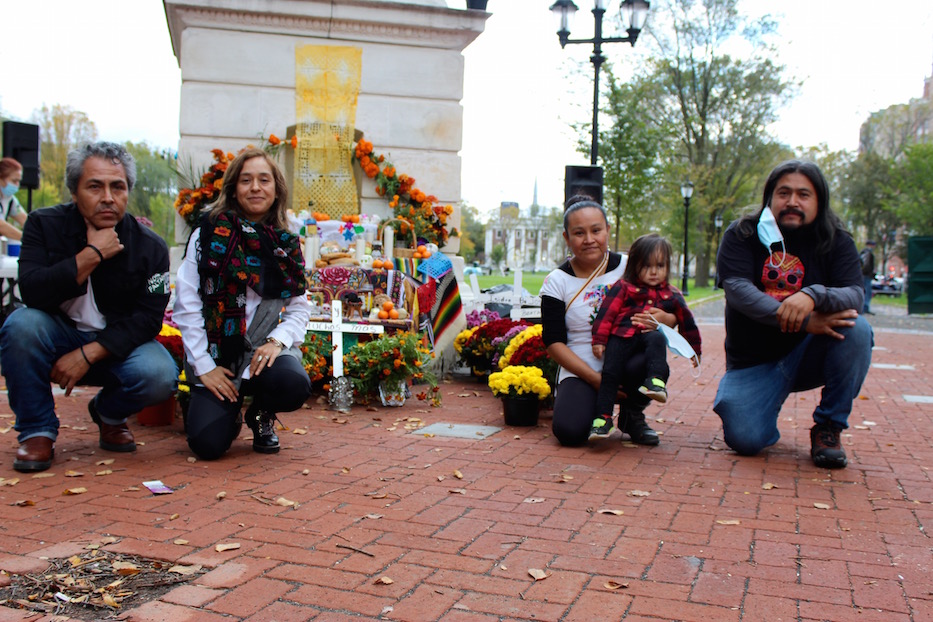
Dia de los Muertos | Downtown | Arts & Culture | Westville | COVID-19 | Arts & Anti-racism
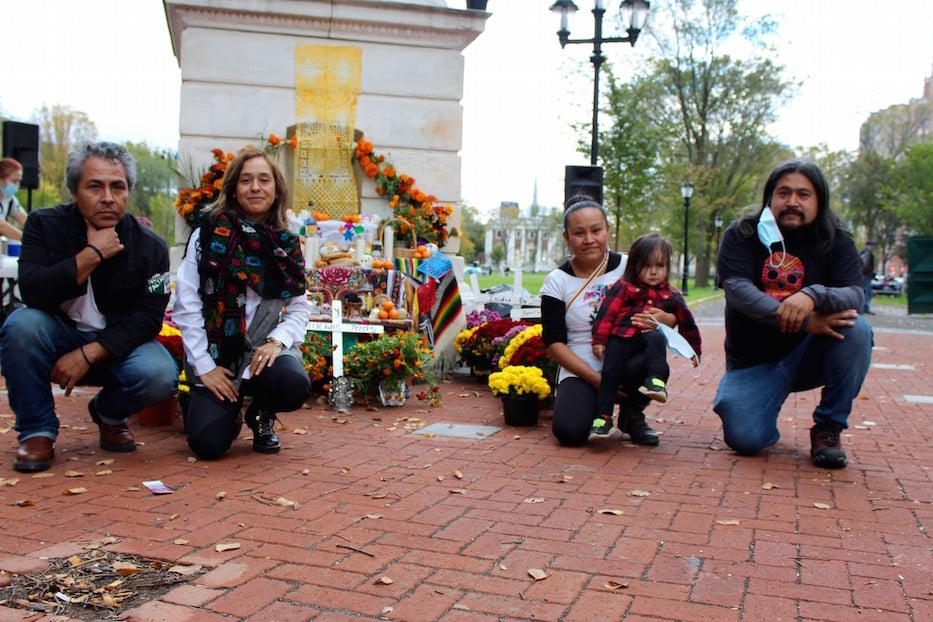
Gabino Trujillo, Sarahi Zacatelco, Enedelia Cruz and Itandehui Foran-Cruz, and Erick Sarmiento. Lucy Gellman Photos.
A thick wreath of marigolds beckoned from the corner of the New Haven Green, climbing up Bennett Fountain in the shape of a sunrise. Paper flags rustled overhead as votive candles glowed below. Around them, sugar-dusted rounds of pan de muerto, tamales, clementines, bottles of mezcal and tequila, and baskets of mums welcomed back the dead. White crosses and electric tea lights stood in two quiet rows on the ground.
Sunday afternoon, a small, community-built ofrenda appeared on the New Haven Green, as a circle of artist-activist friends gathered to usher in Día de Muertos, or Day of the Dead, in the heart of the city they now call home. It marked the culmination of a weekend of celebration, including “Fiesta de Catrinas” Friday night at Amaru Peruvian Bistro in Westville, and music Sunday on the Green.
The latter event commemorated Mexican and Latin American climate activists including Jaime Jiménez Ruiz, Samir Flores Soberanes, and Berta Cáceres, all assassinated while trying to protect the earth.
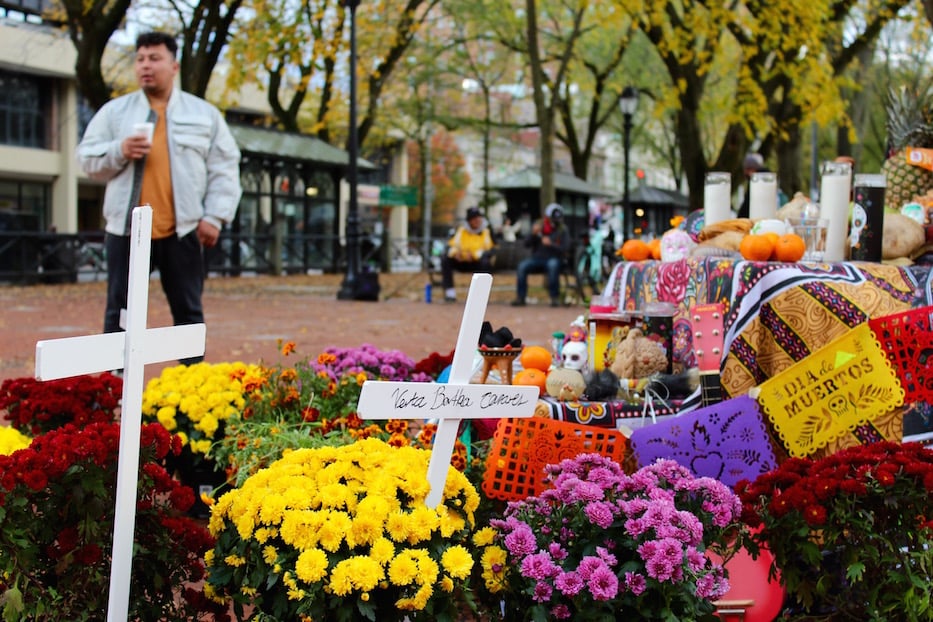
A detail of Sunday's ofrenda. Artist Joel Celi is pictured in the background.
Celebrated at the beginning of November each year, Día de Muertos welcomes spirits of the departed temporarily back into the world of the living. Ofrendas, or altars, wait for them decorated with their favorite foods, including the traditional, sweet and eggy pan de muerto, glasses of water, bottles of alcohol and orange marigolds, which go back to the day’s Indigenous Aztec roots. It is thought that those foods help them find their way on the journey back to this realm.
“It’s everything, you know?” said organizer and artist Sarahi Zacatelco Friday, her face glowing from beneath a crown of fabric flowers and butterflies. “We’re able to celebrate our culture. And please tell people, this is not Mexican Halloween.”
Zacatelco, whose family hails from Oaxaca, noted how hard it is for Mexican immigrants to grieve properly when they are so far away from home. Often, immigration status or the prohibitive cost of travel means that people cannot return for funerals or final goodbyes. In the past 18 months, that reality has been compounded by the pandemic, as people on both sides of the U.S.-Mexico border lose family members suddenly and sometimes violently to Covid-19.
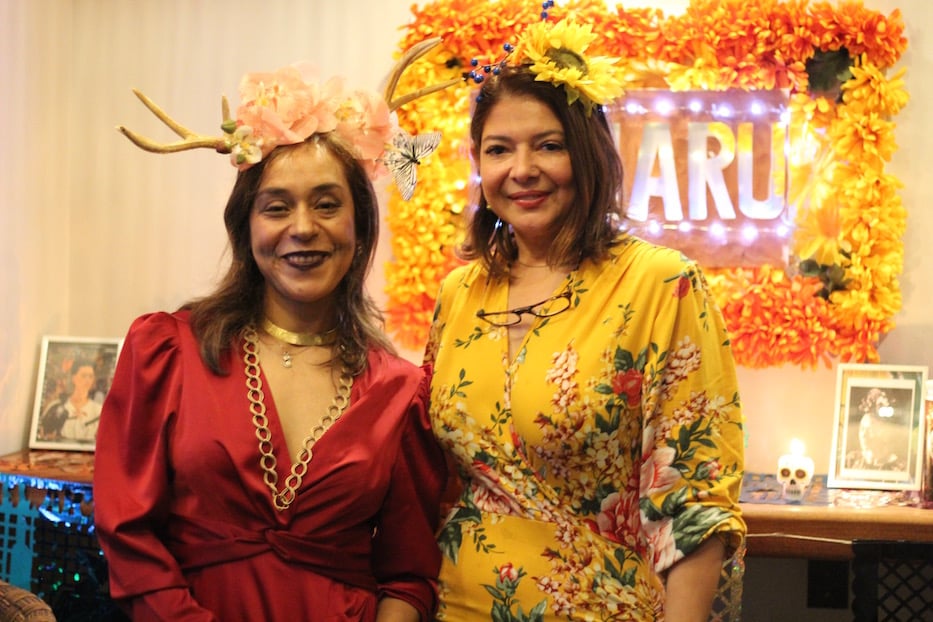
Sarahi Zacatelco and Ana De Los Angeles.
Friday, festivities began with an inaugural “Fiesta de Catrinas” at Amaru, a Peruvian restaurant that comes alive inside Manjares on West Rock Avenue. In September, Manjares owner Ana De Los Angeles invited Zacatelco to do an installation and performance in the space. De Los Angeles said she loves the chance to remember and toast to those she has lost, and has become fond of both Zacatelco and her artwork.
She also observes Día de Muertos in her home, where an ofrenda includes sweets, candles and whiskey for her family members who have died.
Immediately, Zacatelco said, she knew that she wanted to pay homage to the strength and suffering of women—not just in the past year, but across time. During the pandemic, Zacatelco lost her grandmother to Covid-19, and was unable to go home for the funeral. Then several months ago, doctors found a lump in her left shoulder that was cancerous.
The artist, who does not receive health insurance through her day job, worked with Project Access to defray the costs of medical care that she needed. The scar, from an operation in late October, is still a fresh red line that slices across her back.
On a small, flower-studded ofrenda decorated with sugar skulls and candles, portraits of the artist Frida Kahlo beamed and glowered in the low light. Zacatelco said that she feels a kinship with her, particularly at this time of year. She gestured to a table of women that had come out to savor the night with her, some of them wearing their sashes from the Mrs. Señora Connecticut pageant at Bregamos Community Theater earlier this year. What seemed like every 20 or 30 seconds, they stopped a rapid-fire Spanish conversation to break into song.
“All these women, they are miracles,” she said. “Frida—she was a woman, she suffered so much, she survived. I am surviving, like her.”
As Zacatelco floated between a makeshift dance floor and the bar, Brooklyn-based musician Marilyn Castillo cycled through traditional pieces and her own ballads, inspired by her life as a Mexican-American artist now living in New York City. Beside the portraits of Kahlo, her voice rose through the restaurant, hanging on the light fixtures and high ceilings for a moment before it disappeared into the night. A near-constant jingle of a cocktail shaker became her percussion section.
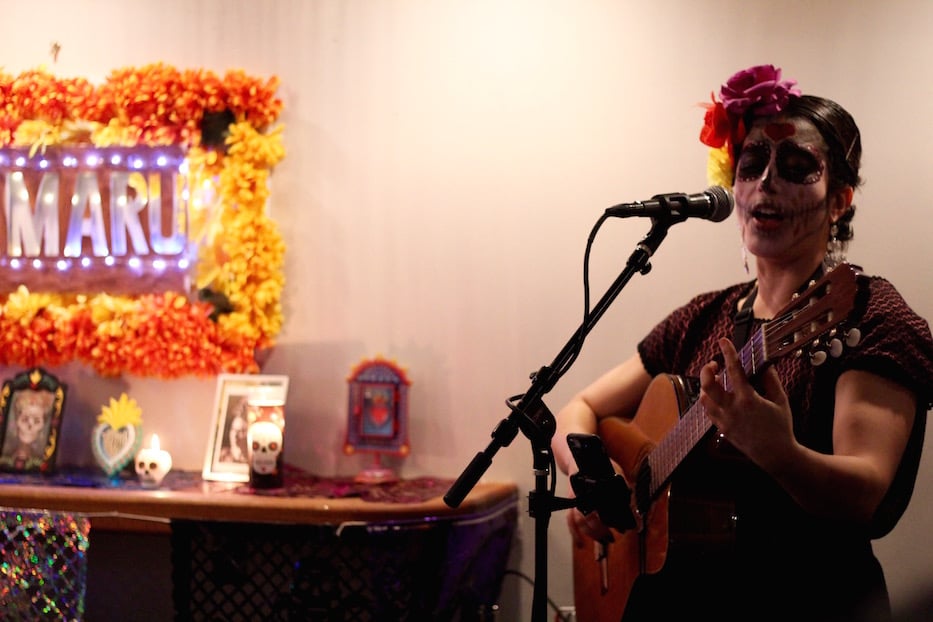
Musician Marilyn Castillo, who grew up in Ciudad Juárez and now lives in Brooklyn.
At one point, she switched to a bilingual version of “Happy Birthday” for someone in the restaurant, joking that it was important to acknowledge the living before they too were gone. Close to the end of her set, she lifted the mood with “Todavia,” the first solo track she ever released. A few attendees rose from their seats and began to dance, hands and feet suddenly in motion. When Zacatelco hit the dance floor, her feet led the way with a decisive, rhythmic clack.
Born in El Paso, Tex. and raised in Ciudad Juárez, Castillo didn’t observe Día de Muertos until she was a teenager, and learned about the tradition in school. That’s fairly common, she said: celebrations of the day are more common in the South of Mexico than they are in the North, but all students still learn about its Indigenous and pre-colonial roots. She still builds an ofrenda each year, to spend time with those who have left the world.
“I just feel closer to home,” she said of keeping the tradition alive from her apartment. This year, she is spending time remembering her late aunt, as well as relatives who passed away from Covid-19, and a nephew who was shot and killed suddenly in El Paso earlier this year. She said that she plans to return to visit her family soon, as she does every year—"It’s like touching base and grounding myself,” she said—but this will keep her steady in the meantime.
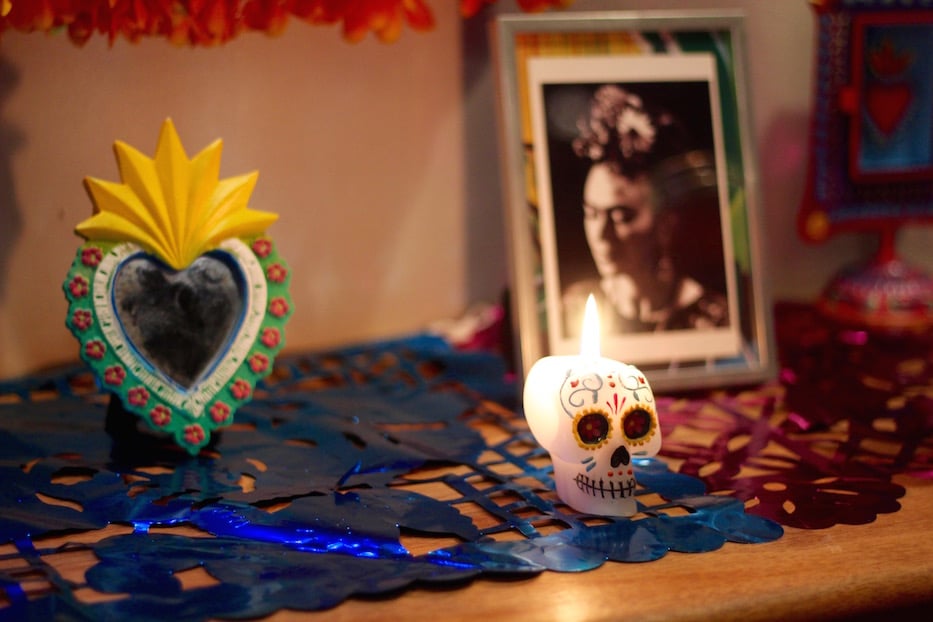
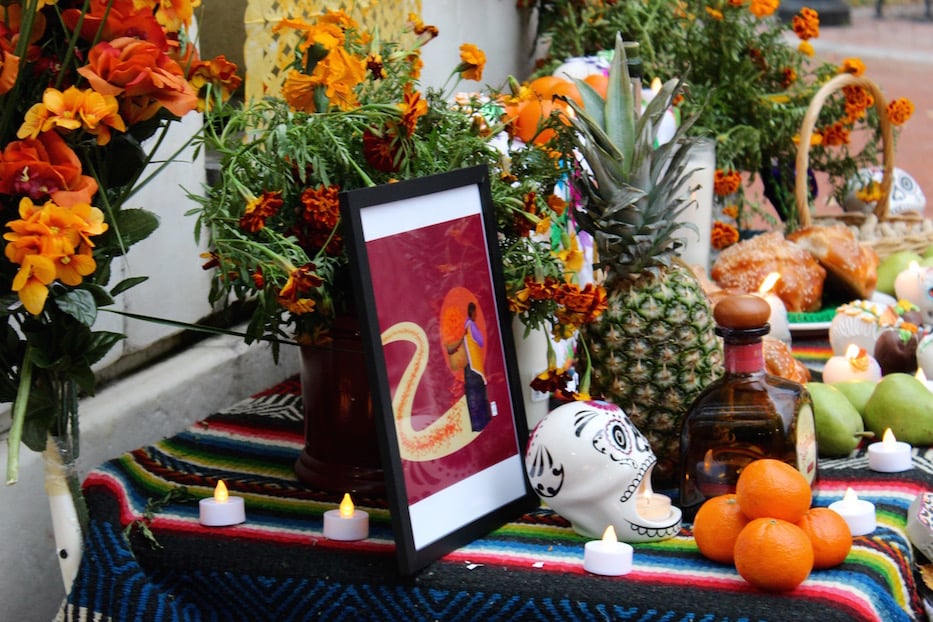
Top: Friday's small ofrenda included candles, marigolds, and portraits of Frida Kahlo. Bottom: Sunday's community ofrenda on the Green.
Sunday, Zacatelco headed to the Green with armfuls of flowers and friends she had enlisted to help build the ofrenda. Last week, she and organizer Erick Sarmiento started talking about making a public altar on the Green, dedicated to climate activists who have been disappeared and killed in their work. Within days, “everybody put something in,” said Sarmiento.
Artist Jesus Abraham Morales Sánchez enlisted his cousin to bake 50 discs of pan de muerto, the circular, raised and yeasty bread that is piled atop ofrendas across the globe. His mother, Martha Sanchez, made hot chocolate that gave off warm, cocoa-scented steam. Other friends pitched in with the flowers and bright textiles, turning folding tables into works of art.
As he listened to Lila Downs’ haunting “La Sandunga” float over the space, Morales Sánchez examined the crosses, each bearing a name of an activist felled while trying to protect the planet, some killed in their own homes. They sprung from between red and yellow mums, as if they were growing right out of the fertile soil.
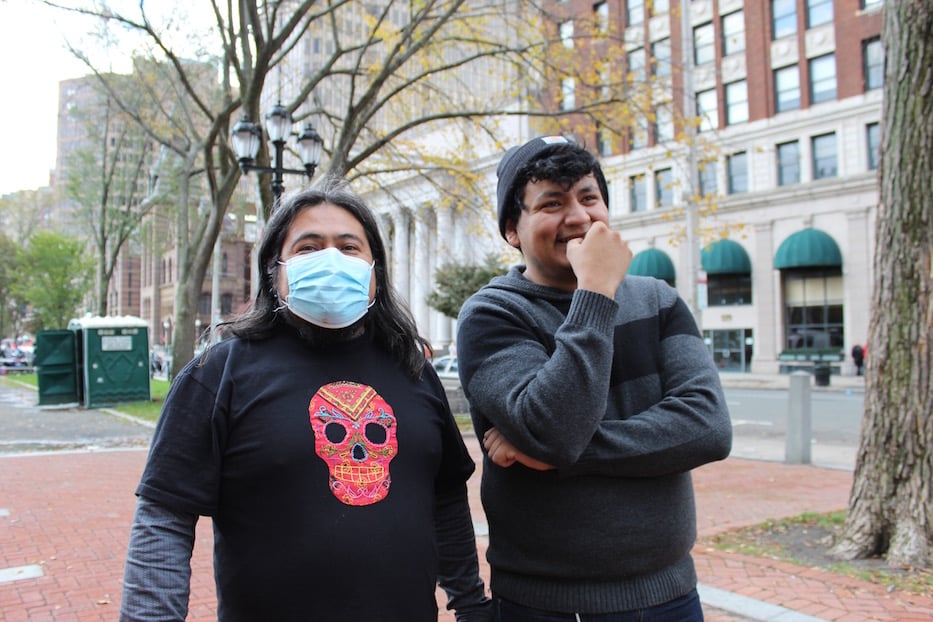
Erick Sarmiento and Jesus Abraham Morales Sánchez.
For him, Día de Muertos brings a sense of peace each year. Eight years ago, he lost his grandfather very suddenly, without a chance to say goodbye. At home, he and his mother make an ofrenda with all of his grandfather’s favorite foods—sweet potatoes, candied pumpkin seeds, tamales with cheese and jalapeño peppers, mole, and salsa verde. The ofrenda always holds at least one Kinder Egg, for a little cousin who died when he was a child. It led him to discover that Kinder Eggs are different in the U.S. than they are in Mexico, where they contain a tiny toy.
There are glasses of water, “because they may be thirsty,” he said—as well as beer, mezcal, and tequila, because “they may also be thirsty." And of course, small, sugar-studded loaves of pan de muerto. This year, he is holding the day especially close: both the artist and his mother have lost friends and relatives from Covid-19. He said that they will keep the altar up at home for at least Monday and Tuesday.
“When you come here as an immigrant, you don’t get that closure,” he said. “Here’s this one day to say: ‘I know that you’re with me. At the end of the day, we’re face to face with our mortality. But seeing this, this is not something that I’m totally afraid of, because I’ll come back.”
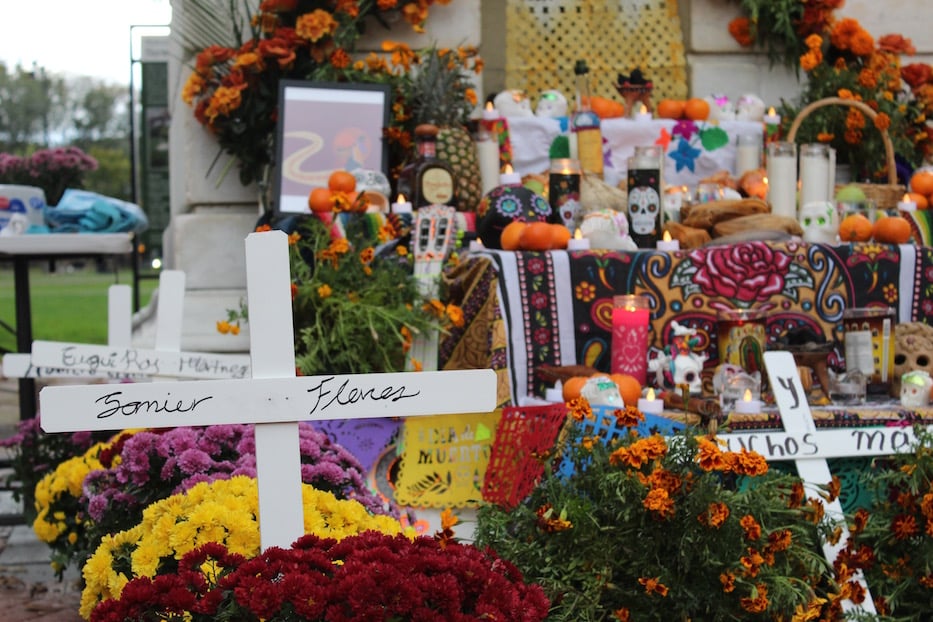
Sarmiento, who is Indigenous Mixtec from Oaxaca, also said that Día de Muertos feels especially urgent to him this year. Last year, his cousin died in a traffic accident. His family was hundreds of miles away in the South of Mexico. There was no way to get his body back to them. As he mourns that loss, he is also reeling from the over 220 climate activists murdered last year, a figure that comes from the organization Global Witness.
“It’s a call for remembering the deaths of these activists,” he said of the community ofrenda. “For me, it’s very important in my culture and my life. In my family, we all light candles, we go to the cemetery, we have conversations about people who have left. We’re able to grieve them.”
“This is to say, stop the violence against these people,” Enedelia Cruz chimed in while bouncing her young daughter Itandehui in her arms. Sunday, she came out to the event with Itandehui, as well as her husband, Joe Foran, and twin sons Joseph and Eddie.
Around them, music rose as Zacatelco flipped on a playlist. Early in the afternoon, attendees had listened to mariachi around the ofrenda.
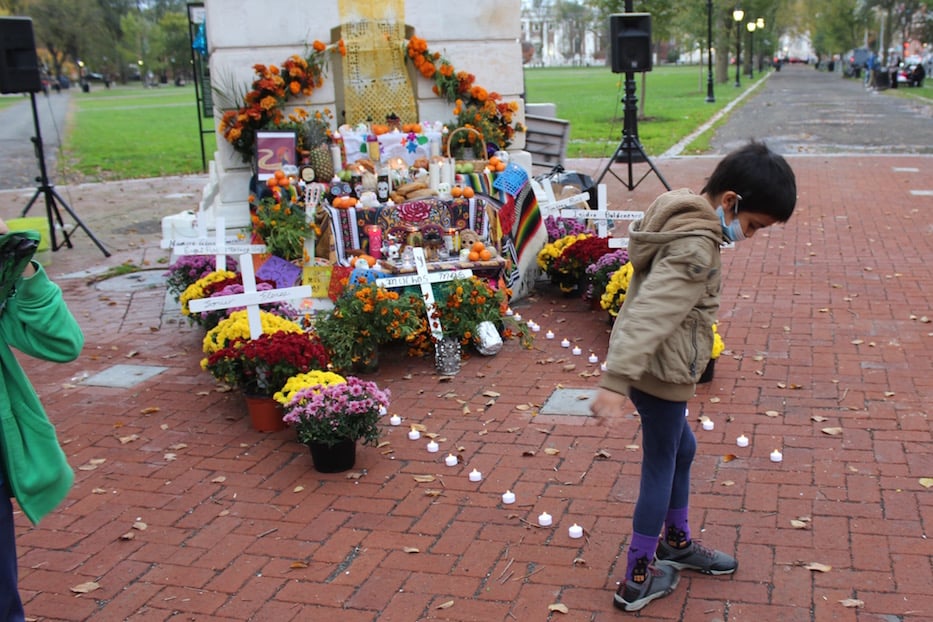
Gabino Trujillo, an organizer and artist in Yonkers who has family in New Haven, drove down for the day to see the ofrenda take shape. As an activist in Yonkers’ immigrant community, he has seen "too many" peers, colleagues, relatives and fellow organizers die in the past 18 months. He said that Día de Muertos helps him grapple with the weight of their loss, and the family members that he misses each year.
“This is part of our culture,” he said, looking over the ofrenda, and then to the busses trundling past beyond it, completely unaware. “My mother passed away. My father. I lost too many friends. But when I see this, I remember them. When we die, we still—”
He held his hands out and then pulled them into his heart, right over his sternum.
“I think, they’re here with me.”

